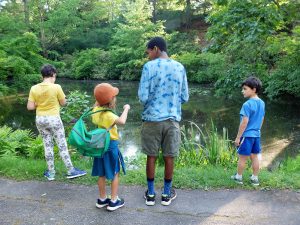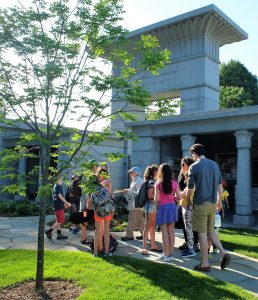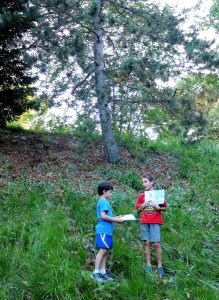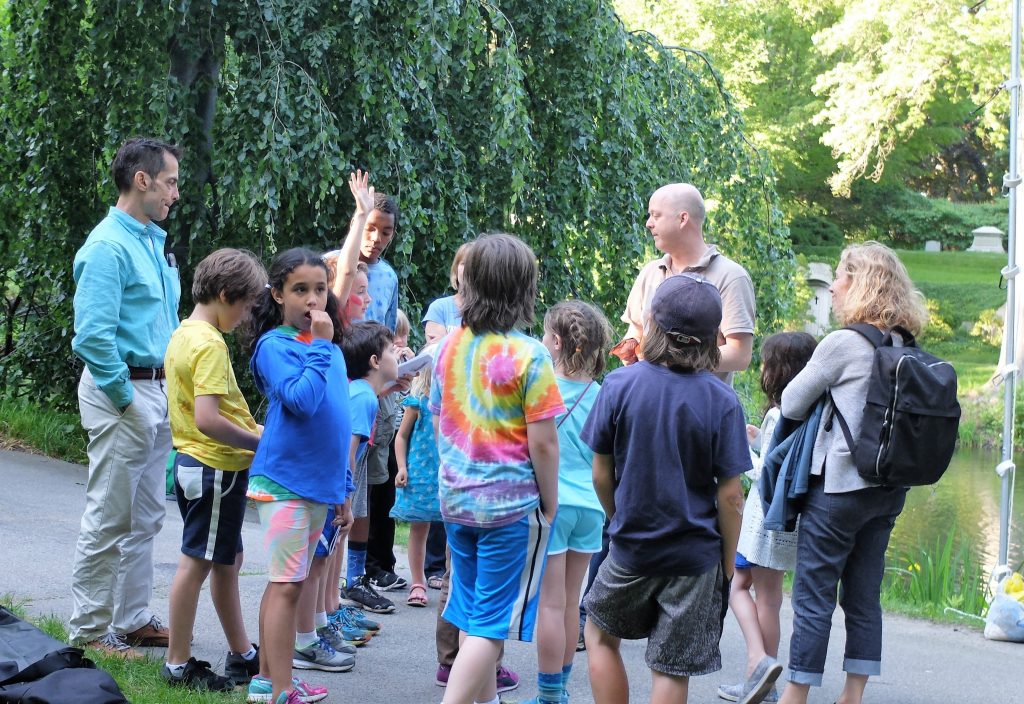A Conversation with Educator-in-Residence Susan Rauchwerk
Mount Auburn is currently partnering with Lesley University thanks to a collaborative two-year grant from the A.J. & M.D. Ruggiero Memorial Trust, to assess the current state of the Cemetery as a wildlife habitat, implement new improvements, and create new opportunities for engaging people on the subject. Already, Lesley researchers have set up studies on site to collect and analyze data on pollinators, ants, bats, birds, air, and water, building upon work that Mount Auburn staff and other consultants have already started here in recent years. A team of educators, in turn, are creating and examining new programs and lessons for student groups based on both these new studies and previously implemented projects from the Cemetery’s Wildlife Action Plan.
 This educational side of the collaboration is being led for the first year by Associate Professor Susan Rauchwerk of Lesley, serving as the A.J. & M.D. Ruggiero Memorial Trust Educator-in-Residence at Mount Auburn. As Rauchwerk described their side of the project, “Our role is to both translate what the researchers are doing and to see where and how our research fits within the Wildlife Action Plan and to expand what audiences look for at Mount Auburn. Are there new audiences we can bring in, and are there opportunities for existing audiences to understand more about the science, and the sustainable practices, and the long-term goals of the Wildlife Action Plan?”
This educational side of the collaboration is being led for the first year by Associate Professor Susan Rauchwerk of Lesley, serving as the A.J. & M.D. Ruggiero Memorial Trust Educator-in-Residence at Mount Auburn. As Rauchwerk described their side of the project, “Our role is to both translate what the researchers are doing and to see where and how our research fits within the Wildlife Action Plan and to expand what audiences look for at Mount Auburn. Are there new audiences we can bring in, and are there opportunities for existing audiences to understand more about the science, and the sustainable practices, and the long-term goals of the Wildlife Action Plan?”
The early stages of Rauchwerk’s work here have centered around understanding both the context of the research that has been done so far, and the experiences and interests of visitors who are currently coming to Mount Auburn. She has met with and watched other researchers in action, from salamander population monitoring to bat data collection, and has gathered information about the habits and interests of visitors when they arrive at the Cemetery. In summary, “I’m trying to understand, across the board, what is the scientists’ research about, and what is the visitor who’s currently utilizing Mount Auburn interested in.”
 Additionally, Rauchwerk has begun to conduct programs with several groups of local students in the first-to-sixth grade age range. By observing people’s experiences and reactions, she can, in turn, plan for more upcoming programs in the summer and fall. “Our approach is: we bring audiences here, and we watch what they do. We’re observers of their interactions. We give them interesting things to contemplate and explore, and then we see where they take it. That helps us shape the program.” That flexibility in using early observations to shape future programs has already shifted some of Rauchwerk’s initial plans. In particular, she has noticed that the student groups are requiring less formal curriculum preparation than she anticipated. Rather, by simply bringing upper elementary and lower middle school groups to Mount Auburn and introducing them in-person to the habitats they are going to focus on, the curriculum creates itself through their participation.
Additionally, Rauchwerk has begun to conduct programs with several groups of local students in the first-to-sixth grade age range. By observing people’s experiences and reactions, she can, in turn, plan for more upcoming programs in the summer and fall. “Our approach is: we bring audiences here, and we watch what they do. We’re observers of their interactions. We give them interesting things to contemplate and explore, and then we see where they take it. That helps us shape the program.” That flexibility in using early observations to shape future programs has already shifted some of Rauchwerk’s initial plans. In particular, she has noticed that the student groups are requiring less formal curriculum preparation than she anticipated. Rather, by simply bringing upper elementary and lower middle school groups to Mount Auburn and introducing them in-person to the habitats they are going to focus on, the curriculum creates itself through their participation.
 Rauchwerk’s early work and observations are already giving her insight into the unique experience of Mount Auburn from the perspective of children – some already familiar with the place, others visiting for the first time, and all “immediately confronted with the idea that it’s a cemetery and that there are dead people here.” She has noted a significant amount of open dialogue among the students, from questions about bones and whether or not being there is “creepy” to noticing and discussing names, dates, and details on monuments in the midst of learning about ecology and wildlife as well. “I loved that they seemed to almost immediately start to think about history, because there’s dates and names that are unfamiliar, there’s all sorts of architecture that can vary on a very short walk…and amidst all of that, they see turkeys and birds and hawks overhead, or squirrels or chipmunks, and so they immediately see the whole ecosystem. The people, the animals, the plants. They’re not segmenting it the way that we might as adults. Like, oh this is a place where people die, and this is a place of sorrow. They’re more curious about what is this place and what does it have to offer. And they definitely are seeking meaning.”
Rauchwerk’s early work and observations are already giving her insight into the unique experience of Mount Auburn from the perspective of children – some already familiar with the place, others visiting for the first time, and all “immediately confronted with the idea that it’s a cemetery and that there are dead people here.” She has noted a significant amount of open dialogue among the students, from questions about bones and whether or not being there is “creepy” to noticing and discussing names, dates, and details on monuments in the midst of learning about ecology and wildlife as well. “I loved that they seemed to almost immediately start to think about history, because there’s dates and names that are unfamiliar, there’s all sorts of architecture that can vary on a very short walk…and amidst all of that, they see turkeys and birds and hawks overhead, or squirrels or chipmunks, and so they immediately see the whole ecosystem. The people, the animals, the plants. They’re not segmenting it the way that we might as adults. Like, oh this is a place where people die, and this is a place of sorrow. They’re more curious about what is this place and what does it have to offer. And they definitely are seeking meaning.”
 Looking ahead, Rauchwerk will be bringing more groups to Mount Auburn for programs, including summer camps and after-school groups, and is looking forward to seeing how they continue to respond. She is also looking to expand to work with older students – undergraduate and high school – and hopes to make the Cemetery available to more people who are interested in science-based internships, such as working alongside wildlife researchers or in the greenhouse, where she notes her excitement about how its technology and recycling system are so seamlessly connected to Mount Auburn’s entire ecology. As a place where wildlife needs and the human needs of a working cemetery are constantly being balanced carefully, working in Mount Auburn’s landscape has been a new experience for Rauchwerk and her team, with many more questions about history and the role of death than they are accustomed to as scientists. This has inspired the unique opportunity to incorporate new areas into their programming while they, in turn, create new ways for Mount Auburn to engage the public in its urban ecology work. “We’re so much at the beginning stages of understanding how all of this works, but there are so many stakeholders who feel so passionately about Mount Auburn, and I’m pretty excited to be able to make this accessible to them, because it’s very clear from the few who have gotten access so far that this is really something they can take hold of. I feel like Mount Auburn has been a leader in lots of ways, and I think they can be a leader in this arena as well.”
Looking ahead, Rauchwerk will be bringing more groups to Mount Auburn for programs, including summer camps and after-school groups, and is looking forward to seeing how they continue to respond. She is also looking to expand to work with older students – undergraduate and high school – and hopes to make the Cemetery available to more people who are interested in science-based internships, such as working alongside wildlife researchers or in the greenhouse, where she notes her excitement about how its technology and recycling system are so seamlessly connected to Mount Auburn’s entire ecology. As a place where wildlife needs and the human needs of a working cemetery are constantly being balanced carefully, working in Mount Auburn’s landscape has been a new experience for Rauchwerk and her team, with many more questions about history and the role of death than they are accustomed to as scientists. This has inspired the unique opportunity to incorporate new areas into their programming while they, in turn, create new ways for Mount Auburn to engage the public in its urban ecology work. “We’re so much at the beginning stages of understanding how all of this works, but there are so many stakeholders who feel so passionately about Mount Auburn, and I’m pretty excited to be able to make this accessible to them, because it’s very clear from the few who have gotten access so far that this is really something they can take hold of. I feel like Mount Auburn has been a leader in lots of ways, and I think they can be a leader in this arena as well.”
Stay tuned for more details about Mount Auburn’s partnership with Lesley University in our next edition of Sweet Auburn, coming this summer!

Leave a Reply